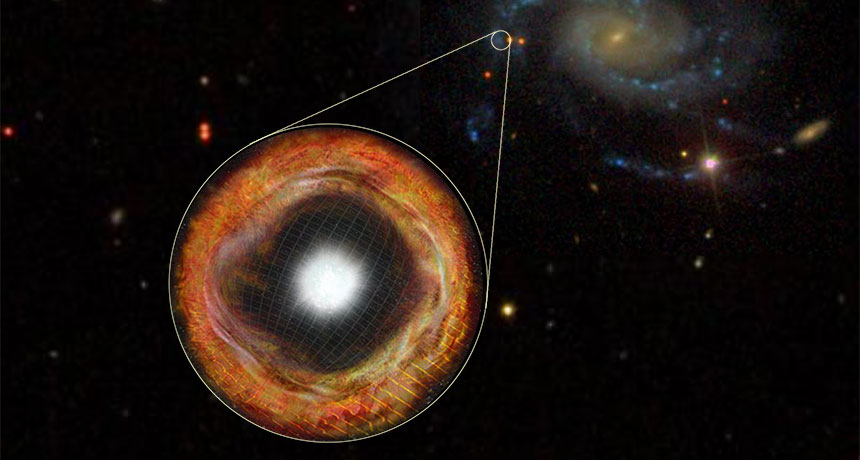Star caught passing gas before exploding
Snapshots of light from hours after the blast give clues to star’s final year

In 2013, astronomers caught a glimpse of a star that exploded in the galaxy NGC7610 (background). Their observations suggest that the star passed gas (center, orange) before the blast.
Ofer Yaron
A star on the brink of death may have been spurting gas for about a year before it exploded, a new study concludes. That comes as a bit of a surprise. Most scientists had assumed the first symptom of a supernova would be the stellar explosion itself.
Three and a half years ago, astronomers caught a glimpse of a star exploding. It was just a few hours after light from the blast first reached Earth.
This was early, astronomers note. “Several years ago, to catch a supernova early would mean to detect it at several days, a week, or maybe more, after the explosion,” says Ofer Yaron. He is an astrophysicist at the Weizmann Institute of Science in Rehovot, Israel. Now, he says, “we talk about day one” when referring to early observations.
Previous supernovas had been spotted this early. But scientists got something extra with this new one: its spectrum. That’s a measurement of the light emitted from the blast, by wavelength (color). The spectrum was measured just six hours after the blast.
The star had blown apart in a type 2 supernova. Such an explosion is triggered by the collapse of a dying star.
Yaron and his colleagues spotted the stellar fireworks with the Intermediate Palomar Transient Factory. Their search used surveys of the sky by a telescope at the Palomar Observatory, near San Diego. The supernova appeared on October 6, 2013 in a galaxy called NGC7610. It resides 166 million light-years from Earth.
The researchers measured the star’s spectrum at several intervals after the supernova got underway. Those data painted a picture of what happened before and after the blast.
As the star exploded, a violent shock wave ripped through the surrounding gas. So violent was the shock wave that it stripped electrons from atoms. Those electrons and atoms later recombined. And when they did, the atoms emitted certain wavelengths, or spectra, of light.
From these spectra, the scientists deduced that the gas outside the star had been emitted before the explosion. Perhaps as much as a year or so before the blast. Yaron and his colleagues described their calculations online February 13 in Nature Physics.
“This is actually very exciting,” says Matteo Cantiello. He is an astrophysicist at the Center for Computational Astrophysics in New York City, and was not involved in the new work. For typical stars on the brink of collapse, “this is the first clear evidence that … the last period of their lives is not quiet,” he says. In fact, he says, it now appears that dying stars may become unstable and rapidly spurt out material.
“That’s very, very odd,” agrees Peter Garnavich. He is an astrophysicist at the University of Notre Dame in Indiana. Scientists typically assume that what happens in the outer layers of stars about to explode have little to do with activities inside the star. The new observations suggest the two are connected, he says. But how an oncoming collapse could provoke the star to spew gas before a star explodes in a supernova, he says, remains unknown.







